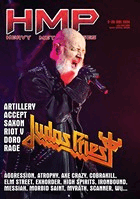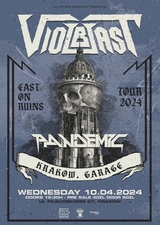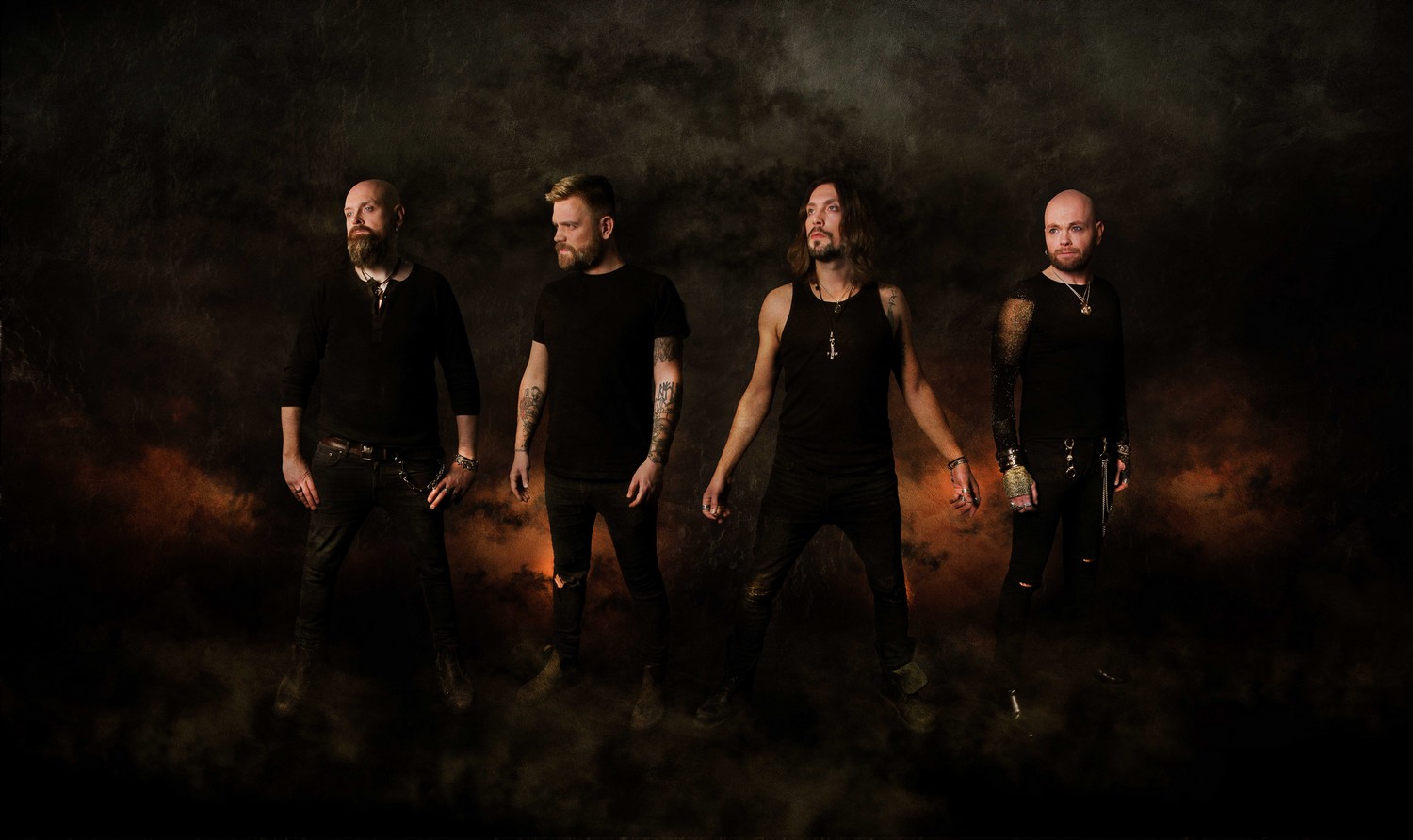“Silence, but also hope” (Dimma) [ENG]
I have been impatiently waiting for the concert of the Icelandic band Dimma. The show, planned for 8th October in the prestigious concert hall Harpa (Reykjavík), would accompany the premiere of their newest album “Þögn”. I was expecting a fantastic heavy metal show, with the most magnificent rock band in this part of the world, in their top shape. During the week before the event Silli Geirdal (Dimma’s bassist and co-founder) gave an interview in writing, and a day before, Ingó (guitarist and co-founder, Silli’s brother) offered to find “a few minutes” backstage at Harpa, to elaborate on the answers. What was supposed to take a few moments, became a full-blown interview. Hence the chaos, but also spontaneity, frankness, and authenticity of this interview.
HMP: Congratulations on selling out all the tickets for tonight’s concert at Harpa. It’s not your first performance here, is it?
Ingó: We’ve played at Harpa with a symphonic orchestra (Sinfonia Nord). Today, however, will be remembered as the first concert played at Harpa by a heavy metal band on their own, without an orchestra.
Bruce Dickinson had a show here promoting his autobiography, but it also wasn’t a typical heavy metal concert (Spoken Word, 16th December 2018). Do you think Harpa is the best possible place for Dimma’s show?
Ingó: Yes, at least in Iceland. Harpa is very beautiful and offers great acoustics. I hope we’ll have a spectacular, unforgettable evening. Of course, it’s up to us, but I’m sure we’ll do a good job. We’ve had a few smaller concerts recently. It’s 1 p.m. now, we have over 7 hours until the event, and we’re already here and getting ready.
It’s exciting – I can’t wait to see you in action! I’ve already had an interview with your brother (bassist Silli Geirdal), thank you both, but now I’d like to talk about some details of your new album, “Þögn” (“Silence”). It starts with “Nætursól” (“Night Sun”). Sounds like a mix between proto-speed metal riffing with melodic hard rock. Did this come from joining two ideas for different pieces?
Ingó: It’s quite interesting. You see, I wrote a completely different song, but the others didn’t like it – except for a small fragment in the middle. I didn’t abandon the idea, I wanted to change it. So I changed the chorus, the verse, even the vocal melody. At the end, just one instrumental section in the middle was left intact. I like it, it’s an interesting structure of guitars, bass and drums, there’s a lot going on. And I made the vocals slower and more melodic, to add contrast. Imagine you stand in the eye of a storm, but within some distance around you, there’s silence. That was the idea.
You mentioned the bass guitar in “Nætursól”, but I think the bass is even more prominent in some other parts of the album. For instance in “Almyrkvi” (“Total Eclipse”), which has the most interesting harmonies and a few dynamic jumps. It begins as a moody ballad, but suddenly becomes a hot metal killer. Later on, you abandon the guitar solo after just ten seconds and move into an intriguing vocal harmony, continued later on. What are the lyrics about?
Ingó: Generally, it’s about rising from the ashes after a dark time ends. In a way, we encourage the audience to let go of their bad experiences from the past, regenerate, start something new. There’s hope of a better tomorrow, and it’s worth mentioning that our last three albums had a darker, more melancholy tone. Darkness still dominates in our new pieces (“Dimma" means “darkness” in Icelandic), but now there’s a light at the end of the tunnel. That’s also why in the album cover there’s a gentle woman with flamingos around her.
I was rather thinking the femme fatale is riding one beast, not a group of flamingos.
Ingó: You can interpret it like this, but notice that the woman is in a relaxed pose, she’s connecting with her inner self. She’s feeling light, serene, which makes our cover unusual for hard rock or heavy metal. Bands tend to use the same things for their covers – like dragons breathing fire. Granted, they look cool, but I’d personally leave them for Dio (which I love listening to, by the way). If everyone keeps repeating it, a good idea eventually becomes a cliché. We wanted to do something different. At the end, there is silence in our cover, but also hope at the same time.
Speaking of women, you have a special guest in “Þögn”: Guðrún Árný. She sang in “Andvaka” (“Sleepless”).
Ingó: Guðrún is an interesting guest, especially that her musical genre is completely different. We could call her a diva, an Icelandic version of Céline Dion. We invited her to surprise the fans, no-one would have expected her. She’s not a pop star, that would be too mundane, she’s a diva. We thought our collaboration would be interesting. She sang and recorded “Andvaka” 15 years ago. It didn’t become a hit, but it was always one of my favourites. You can think of it as our cover, but we made sure to rearrange it to really fit Dimma’s character. The original was played on a piano and strings, while we made it into a hard rock ballad.
You can’t deny your music is full of great melodies, but also sharp guitar parts, and every now and then you have some cool rhythmic solutions. I’m wondering how much you were inspired by Zakk Wylde, let’s say in “Paradísarheimt” (“Paradise Restored” – editor’s note)?
Ingó: Zakk could have inspired me, definitely. I’m a fan of Ozzy Osbourne, so I often listen to Zakk Wylde. Ozzy used to play with Randy Rhoads, my favourite guitarist of all time. HowevEer, when composing “Paradísarheimt”, I was thinking of Jimmy Page, Slash, Angus Young.
One more question about the lyrics. Have you ever mentioned Hurðaskellir or any other of Iceland’s thirteen Santas in your texts?
Ingó: No, never.
Oh... Anyway, would it be fair to say Dimma’s “Þögn” is the best album in the history of Icelandic rock?
Ingó: I wouldn’t mind if you did (laughs). It’s certainly the best album in our own discography.
(Ingó offered “a few minutes” for the interview, but seeing he was very relaxed, I opened up the next topic.) Before we end, could I ask how Iceland knew about heavy metal before the Internet became common in Icelandic households? Did the local mainstream media ever cover heavy metal?
Ingo: Mainstream media, no, not really. You know, I set up my first heavy metal group in 1982, as a child. I bought my first guitar when visiting my aunt in Seattle (Washington, USA). I returned to Iceland with an electric guitar and a bass bought in the US (the latter was for my brother). We still have that bass. That was the beginning, at least for us. Back then, we were inspired by classic rock, bands like Alice Cooper, Led Zeppelin, Frank Zappa, and AC/DC and Judas Priest a while later. We were already deeply engaged in heavy metal, but Iceland had no scene of the sort. Our first album (with my brother) was released in 1996. Our band was called Stripshow. You can check it out, just don’t search “Stripshow” on YouTube, because you might find a lot of other things (laughs). You can also find it on Spotify. The lyrics are in English. Interesting music, I’m still proud of it.
Thanks. I’ll be sure to check it out. (Ingó writes names in my notebook: LP: “Late Nite Cult Show”, videos: “Where Are We Now?”, “Blind”, “Whiplash”, “Psychodrama”, “War Pigs”, “Sentimental Jacks”). It seems you imported heavy metal from the US to Iceland.
Ingó: Yeah, others did it, too. Dimma had its debut (LP “Dimma”) in 2005 and our second album came out in 2008 (LP “Stigmata”), but heavy metal only came out of a deep underground around 2010. I’ve written some names of videos, you can find them on YouTube. There’s even a cover of “War Pigs” by Black Sabbath. We added that cover when finishing the recording. It wasn’t really in our plans, but we thought “why not?”, and now you can hear it.
I will. Thank you. As mentioned, I’m excited for tonight’s show.
Ingó: Yeah, me too. Hey, interesting you have a T-shirt with Judas Priest’s “Firepower”. For me, it’s one of their biggest accomplishments. I’ll admit we used it as a standard when mixing “Þögn”. (Some commotion in the room, then Ingó goes on.) Also, I like Iron Maiden’s new album. “Brave New World” is my favourite one after Bruce Dickinson came back, but who knows, maybe with time “Senjutsu” will be considered as even better. I like the complex arrangements of those pieces.
It’s good they don’t eat their own tail, don’t repeat themselves, but keep trying new things. I’ve never heard Iron Maiden play blues for instance, but there is some in “Senjutsu”.
Ingó: As well as folk.
But they had a bit of folk in “Dance of Death”.
Ingó: True – “Journeyman” and so on.
You said Judas Priest’s “Firepower” was your reference point.
Ingó: Not when composing, only when mixing the whole album. We wanted a similar sound, because it’s so perfect, maybe the best in the history of heavy metal.
Firepower, Power of Fire – it has a lot to do with magic, and you’re not only a musician, also a magician.
Ingó: Magic & music are both performing arts that require a certain discipline, passion and commitment in order to express yourself in an artistic way and share your vision with other people. Music has the power to touch, heal, inspire and connect people. Music is magic. I’m going to show it on stage tonight. When we played with the orchestra, it was also magic, but of a different type. I’ll show you a photo (Ingó unwraps a CD from Dimma’s concert with orchestra). Look, it’s the same place.
I’ve seen it. I thought you did the same that Metallica and Deep Purple once had. Bands with a developed career sometimes use an orchestra because feeling accomplished in their own field, they want to do something else.
Ingó: Of course. Deep Purple was the first to do it. In our case, we had a 70-person orchestra.
My favourite combination of metal with symphonic orchestra is the Swedish band Therion. Are you a fan of them?
Ingó: I’ll check them out. The name is familiar to me, but I’ve never really listened Therion.
Therion first performed death metal, but then changed their mind. They felt done with music and only intended to do one strange experiment. They didn’t care what fans would think, the members were done with Therion. With no pressure, they made the ground-breaking “Theli” (1996), which turned out to be not the end, but the beginning of their tremendous musical career. What do you think, is also Dimma’s turning point yet to come? Everyone in Iceland knows and loves Dimma, but you don’t realise your potential abroad.
Ingó: It’s because we sing in Icelandic and focus exclusively on Iceland. We’d like, however, to perform on festivals abroad, do some tours etc. It would be wonderful if we could introduce Dimma to the international metal scene. This could be our future turning point.
People can enjoy music whether they understand the lyrics or not. The history of rock has demonstrated it more than once, look for instance at Spanish-speaking (as well as Japanese-speaking) fans who are crazy about heavy metal songs with lyrics written in English. Dimma plays a great metal, different from everything else. Your instrumental parts are unique. There’s a good chance that if foreign metal fans heard you, they would love Dimma immediately, regardless of whether they understand Icelandic.
Ingó: Thanks. That’s true. The industrial band Rammstein has lots of fans who don’t know German. Their music is nothing like ours, but I like them, since they give a good show with incredible pyrotechnics.
And in Iceland, is there a band similar to yours that sings in Icelandic and you would recommend?
Ingó: My friends from Nykur (Ingó writes in my notebook again). They also play melodic heavy metal, but not the same as Dimma. Nykur in Icelandic means “horse” (and indeed, they have a horse on their cover). There are no horses on ours, but we have flamingos. I’m not someone to talk about animal symbolism. The cover for “Þögn” was made by Ólöf Erla Einarsdóttir - my brother Silli’s fiancée. She’s responsible for most of Dimma’s covers since 2014. We didn’t suggest the flamingos, it was her idea. I don’t want to speak for her, but I think the woman sitting on the flamingos is the personification of calmness.
Recently, Iceland has been known for pursuing gender equality. Making a woman the main visual representative in the physical release of “Þögn” goes with this trend.
Ingó: Definitely! The lady in the cover rules the flamingos. Her countenance is more powerful than dragons, it can tell us more than the monsters associated with metal. We’ve seen the metal dragons so many times that they don’t impress any more.
Women are not new to the world of rock and metal, but they don’t appear so often. Are the Icelandic rock and metal bands made up only of men?
Ingó: No. Dimma had a second guitarist who was female (from 2006 to 2010), but only during concerts. She didn’t perform for any of our studio albums with new pieces. At that time, Dimma was a quintet, and after she left, we became a quartet, just as now.
Dimma consists of you playing the guitar, your brother on the bass, vocalist Stefán Jakobsson and Egill Örn Rafnsson as the drummer. The latter is a new character in your line-up.
Ingó: That’s right. Egill joined us at the end of 2018. His predecessor lost his heart to our music. Egill is one of the best drummers in Iceland. He has an advanced technical skills and an excellent feel for music. He’s been our friend for twenty years. He knew all our songs, but learning how to play them took him a few months. When he joined us, our previous pieces changed – we didn’t rearrange anything, his drumming is just different. We never planned any changes, they simply happened. Usually, when a new person joins, the chemistry of the band changes immediately, and a change in its sounds follows.
Two weeks ago, I’ve heard from Volcanova they wanted to perform before you today at Harpa. You said no because your set would be too long. You’re going to play the whole “Þögn” and then some older pieces, right?
Ingó: Yes, that’s right. The first part will be 50 minutes (“Þögn”), then we’ll have a break, and then we’ll play something else for 70 minutes. You’ll hear the best songs from each of our studio album.
I think the first thing by Dimma I’ve ever heard was “I smoke”. I was wondering why you would sing about smoking cigarettes...
Ingó: Wait a moment (tries to remember). Ahh, I know what you mean. “Ég Brenn” is not about cigarettes, it’s about burning from the inside. A burning heart.
Did you hear what happened to Ritchie Faulkner from Judas Priest? He had an aortic aneurysm, and still finished the concert at Louder Than Life. You said Dimma’s previous drummer left because he lost his heart, and Ritchie Faulkner was the opposite – even if his heart fell apart physically, he would play until the end.
Ingó: Ritchie Faulkner is amazing. Me and my brother also have a heart for this music. We’d been doing it for decades before we gained any success at all, because it’s set deep in our hearts. And we’ll go on, even if almost nobody comes to listen to us.
I can’t imagine it, you’ve just filled Harpa to the brim.
Ingó: Yeah! Thanks for the conversation and see you at the concert.
Sam O’Black













